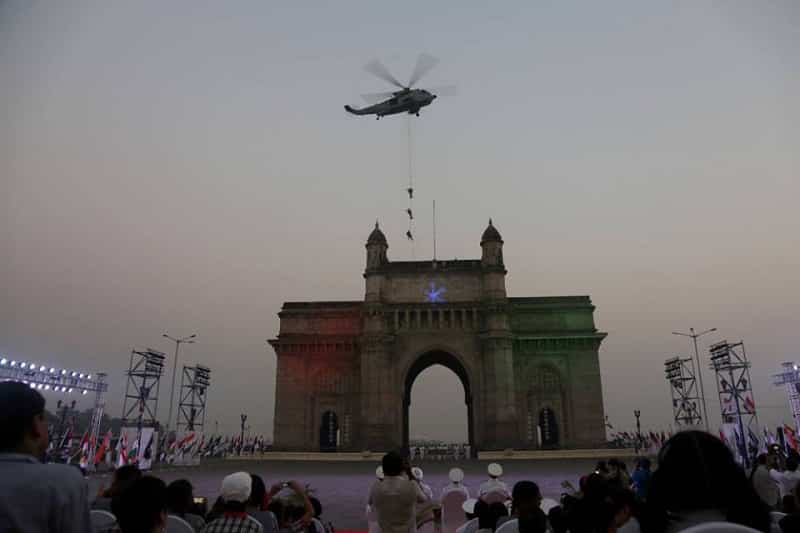Gateway of India: The Pride of Mumbai
All over the world, people believe that welcoming a guest or a family member to the home or city should be done in a way that the people arriving are relieved of the stress or discomfort they might have faced during the journey. Many arrangements are done in order to welcome the guests or people who hold special importance in our lives. The significance of welcoming someone to a new place becomes all the more important when a person or a group arrives at the place for the first time. People go to the extent of dedicating a memorial to a person for his/her visit and stay at a particular place. Following this tradition, the Gateway of India was constructed on the Apollo Bunder as a memorial for King George V and Queen Mary. It is a remembrance of their first visit to India in 1911.

Location
The Gateway of India is built in Mumbai, the capital of Maharashtra and the most populous city of India. The foundation stone was laid by the then Governor, Sir George Sydenham Clarke on March 31, 1911. The design of the gateway was created by an architect named George Wittet from Scotland.
History
Although the foundation stone was laid in 1911, the construction did not begin till 1915. The land that was to be used to build this historical monument was reclaimed in a period of four years, and the foundation work was completed in the following year. Another four went into the construction of the gateway. It was on 4 December, 1924 that the opening ceremony was held with the Viceroy Rufus hiIsaacs dedicating this historical structure.
The gateway became a significant structure, as the Viceroys and Governors arriving in India always used it to enter the mainland. It became a sign of the power of the British Empire that was ruling over India during the period of its construction.
When India got independent, the last troops exited from the gateway on 28 February, 1948, which marked the end of the British rule in India.
Today, the gateway is a historical monument and one of the most visited places by the local residents and visitors. Built next to the gateway is the famous Taj Mahal Palace and Tower, a five star hotel. There is a statue of Chhatrapati Shivaji Maharaj adjacent to the gateway, which was established in 1961. A statue of Swami Vivekananda is also built near the gateway.
The gateway survived a bomb blast that happened in a taxi parked near to it in 2003. It is the place from where the terrorists who attacked the Taj Mahal Palace and Tower in November 2008 disembarked. Following the terror attacks, certain areas were prohibited from being accessed by the public.
The Archaeological Survey of India (ASI) now owns this historical gateway.
Structure
The Gateway of India represents a classical combination of two major architectural styles (the Hindu and the Muslim), put together with Roman triumphal arch and constituents of the Gujarat architecture of the sixteenth century. The gateway has been constructed using yellow basalt and reinforced concrete. The gateway opens to the Mumbai Harbor.
The construction materials, i.e., the stones were made available from the local resources, where the screens had been procured from Gwalior.
With a diameter of 48 feet, the central dome rises to a height of 83 feet when measured from the ground. The halls built near the arches have the capacity to accommodate 600 people at a time. The total cost of constructing the fort was Rs 21 lacs paid by the Indian Government. Due to unavailability of funds, the construction of the approach road that would lead to the gateway was never carried out.
Gammon India, a civil engineering company based out of Mumbai, led the construction under the supervision of the government engineers. The construction is said to be completed in a record time. The in-charge of the whole process was Deewan Bahadur Kikkeri Ramaswamy. His name has been inscribed on the gateway as a honor to his contribution.
What to See
You will never have a dull moment during your visit to this unique and mesmerizing tourist spot. The place is always bustling with local residents, tourists from other cities and states and ever foreign nationals. There are a lot of roadside vendors that sell food items and other goods to the visitors, including giant air balloons.
The gateway is a heaven for photographers as a beautiful landscape surrounded by people and skyscrapers and ancient structures fills the essence of the hustle and bustle of the city to what you click and shoot.
From the gateway, jetties are available to nearby locations where a lot of tourists head to. You can take a ferry ride to Alibaug, a coastal town of the Raigad district. It is an ancient town with a lot of beaches, a temple and a historic fort.
You can also take a ferry to the Elephanta Caves, a cluster of ancient Hindu and Buddhist caves that are said to date back to the eighth century.
An event called “Elephanta Festival of Music and Dance”, which was previously organized at the Elephanta Caves, is now held at the Gateway of India, as it can accommodate up to 2500 people, three times more than to what Elephanta Caves can accommodate.
Eat, Drink, Collect
Being the most populous city and commercial capital of India, the streets of Mumbai are full of eating outlets and shops from where you can purchase a wide range of products that can be of great utility for everyday life or can add value to your collection of decorative collectibles.
The restaurants and outlets near Gateway of India include The Leopold Café, Café Mondegar, Bagdadi Restaurant, Café Churchill, Not Just Jazz By The Way, Stadium Restaurant, Gaylord Restaurant, Kamling, Samrat, etc.
Best Time to Visit
The Gateway of India is one historical place that is open all year long and where the visitors are not expected to pay any admission charges. You just need to be careful during the monsoon season, as the rains of Mumbai are notorious for washing away anything that comes along its way and cause water logging that brings the life to a standstill of this otherwise fast moving city.
How to Reach
Mumbai is connected to almost all major cities of India through rail and air transport. It is also well connected to the neighboring cities and states through road network. The Mumbai Pune Expressway has a six-lane road that has considerably reduced the time spent to cover the distance between Mumbai and Pune. This expressway is open for four-wheelers only. The commuters will have a nice time traveling through this expressway, as it is less time consuming and also offers scenic views of the Sahyadri mountain range and the villages throughout the way.
The Gateway of India is a splendid structure that stands apart on a scenic location and captures the attention of every visitor with its authentic appeal and beauty. Your visit to Maharashtra, especially Mumbai, is incomplete if you do not find time to spend and explore this historical gateway.


